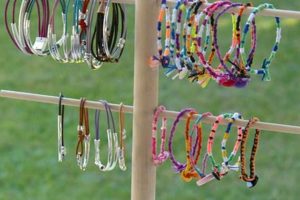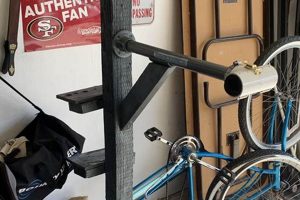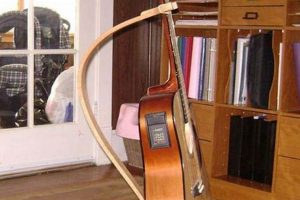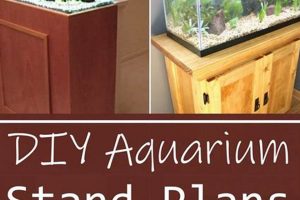A structure designed to support a 75-gallon aquarium, constructed by an individual rather than purchased pre-made, offers a customizable and potentially cost-effective solution for housing aquatic environments. These self-built supports can be tailored to specific aesthetic preferences and spatial requirements. For example, an individual might construct a wooden frame with a reinforced top panel to safely bear the weight of a filled aquarium.
Creating a personalized aquarium support offers several advantages. It allows for precise dimensional control, ensuring a perfect fit within a designated space. Furthermore, the process can result in significant cost savings compared to purchasing a commercially produced stand. Historically, crafting one’s own furniture, including aquarium supports, was a common practice, predating mass manufacturing and offering a means of achieving desired functionality and aesthetics.
The following sections will delve into the critical aspects of designing and building a stable and visually appealing support for a 75-gallon aquarium, focusing on material selection, structural considerations, and finishing techniques.
Construction Guidelines for a 75-Gallon Aquarium Support
The creation of a stable and reliable aquarium support necessitates careful planning and execution. The following guidelines offer crucial considerations for the process.
Tip 1: Material Selection: Employ pressure-treated lumber or hardwood for framing to resist moisture and prevent decay. Softwoods, while less expensive, may require extensive sealing and are generally less durable. For example, kiln-dried pine, sealed with multiple layers of epoxy resin, could be used, though hardwood such as oak is preferable.
Tip 2: Load-Bearing Capacity: A filled 75-gallon aquarium can weigh upwards of 800 pounds. Over-engineer the structure by increasing the dimensions of load-bearing members beyond the minimum calculated requirements. For example, use 2×4 studs spaced no more than 16 inches apart, or opt for 4×4 corner posts for enhanced stability.
Tip 3: Leveling and Stability: Ensure the floor surface is perfectly level before construction begins. Incorporate adjustable leveling feet into the design to compensate for minor floor imperfections. Uneven weight distribution can compromise the structural integrity of the support. A bubble level should be used throughout the build process.
Tip 4: Surface Preparation: The top surface of the stand must be perfectly flat to prevent stress points on the aquarium glass. Use a high-quality plywood or MDF board for the top panel, and ensure it is securely attached to the frame. Apply a layer of closed-cell foam or a similar cushioning material between the top panel and the aquarium base.
Tip 5: Joinery Techniques: Employ robust joinery methods, such as screws, bolts, and wood glue, to create strong and reliable connections between framing members. Avoid relying solely on nails or staples, as they may loosen over time. Consider using pocket-hole joinery for concealed and secure connections.
Tip 6: Water Resistance: Apply multiple coats of a waterproof sealant or paint to all exposed wood surfaces to prevent water damage and prolong the lifespan of the stand. Consider using a marine-grade varnish or epoxy coating for maximum protection. Pay particular attention to sealing joints and edges.
Tip 7: Ventilation: Design the stand to allow for adequate ventilation to prevent moisture buildup and mold growth within the enclosed space. Incorporate vents or openings to promote airflow around the aquarium equipment. Position the vents away from potential water splashes.
Tip 8: Aesthetics: Consider the overall aesthetic of the room and choose a design that complements the existing dcor. Select appropriate finishes and hardware to create a visually appealing and functional piece of furniture. Consider incorporating features such as doors, drawers, or shelving for additional storage.
Adhering to these recommendations during construction will result in a durable and safe aquarium support, providing peace of mind and a stable foundation for a thriving aquatic ecosystem.
The subsequent section will provide a detailed step-by-step construction guide, illustrating the practical application of these principles.
1. Structural Integrity
Structural integrity is paramount in the construction of a support for a 75-gallon aquarium. The aquarium, when filled, exerts significant weight, placing substantial stress on the supporting structure. A lack of sufficient structural integrity can lead to catastrophic failure, resulting in damage to the aquarium, surrounding property, and potential injury.
- Material Selection and Load Capacity
The choice of materials directly influences the load-bearing capacity of the support. Selecting wood with inadequate strength or resistance to bending can compromise the entire structure. For example, using low-grade lumber instead of hardwood significantly reduces the stand’s ability to support the aquarium’s weight. Exceeding the material’s load limit can cause warping, cracking, or complete collapse.
- Joint Strength and Stability
The method of joining the structural members is critical for maintaining stability. Weak joints, such as those relying solely on nails or staples, are prone to failure under sustained load. Using robust joinery techniques, like screws, bolts, and wood glue, distributes stress more effectively. For instance, a poorly constructed corner joint will buckle under pressure, leading to instability and potential structural failure.
- Base Support and Leveling
An uneven or unstable base undermines the entire structure. Uneven weight distribution concentrates stress on specific points, weakening the support. Implementing adjustable leveling feet and ensuring a level surface minimizes stress and ensures even load distribution. Neglecting this step can lead to gradual deformation and eventual collapse.
- Resistance to Shear Forces
Aquarium supports must resist shear forces, which are forces acting parallel to the structural members. Shear forces can cause the support to shift or deform over time. Diagonal bracing adds significant resistance to shear forces, preventing racking and maintaining the structural integrity of the stand. Without adequate bracing, the stand becomes susceptible to lateral movement and potential collapse.
The interconnectedness of these elements underscores the importance of a holistic approach to structural integrity. Each component contributes to the overall stability and load-bearing capacity of the support. Proper material selection, robust joinery, a stable base, and resistance to shear forces are all essential for ensuring the long-term safety and reliability of a support built for a 75-gallon aquarium.
2. Material Durability
Material durability is a crucial consideration in the construction of a support for a 75-gallon aquarium. The materials used directly impact the stand’s ability to withstand moisture, weight, and the passage of time, ultimately determining its lifespan and the safety of the aquarium.
- Water Resistance and Decay
The primary threat to aquarium supports is water damage. Prolonged exposure to moisture can lead to rot, warping, and structural weakening of wood-based materials. For example, untreated softwood will quickly degrade in a humid environment, whereas pressure-treated lumber or hardwood, sealed with a waterproof coating, offers superior protection against decay. Choosing materials with inherent water resistance is vital for long-term durability.
- Load-Bearing Capacity and Deformation
The materials selected must be capable of supporting the significant weight of a filled 75-gallon aquarium without deformation. Over time, materials with insufficient strength can exhibit sagging or bending, compromising the stability of the structure. For instance, thin plywood or under-dimensioned lumber may gradually bow under the weight, creating stress points on the aquarium glass. Selecting materials with adequate load-bearing capacity is essential for preventing structural failure.
- Resistance to Biological Growth
Humid environments promote the growth of mold and mildew, which can further degrade wooden structures. Selecting materials that are resistant to biological growth or applying antimicrobial treatments can mitigate this risk. For example, using redwood or cedar, which contain natural oils that inhibit fungal growth, or applying a mold-resistant sealant can significantly improve the stand’s longevity.
- Fastener Compatibility and Corrosion
The fasteners used to assemble the stand must be compatible with the chosen materials and resistant to corrosion. Using inappropriate fasteners can lead to premature failure of the joints. For example, using untreated steel screws in a damp environment will result in rust and weakening of the connection. Selecting stainless steel or coated fasteners ensures long-term durability and prevents structural compromise.
In conclusion, the selection of durable materials is paramount for ensuring the long-term stability and safety of a support for a 75-gallon aquarium. Considerations such as water resistance, load-bearing capacity, resistance to biological growth, and fastener compatibility must be carefully evaluated to prevent premature failure and maintain the structural integrity of the stand.
3. Load distribution
Load distribution is a critical factor in the design and construction of a support for a 75-gallon aquarium. The weight of the filled aquarium must be evenly distributed across the supporting structure to prevent stress concentrations and ensure long-term stability.
- Surface Area Contact
The surface area of contact between the aquarium and the support directly affects load distribution. A larger contact area spreads the weight more evenly, reducing stress on any single point. For example, a support with a thin frame and minimal contact area will concentrate the weight along the frame’s edges, potentially causing warping or cracking. Conversely, a support with a solid, flat top panel provides uniform weight distribution, minimizing stress on the aquarium glass and the supporting structure itself.
- Frame Design and Reinforcement
The internal framework of the support plays a crucial role in distributing the load. A well-designed frame incorporates vertical supports (e.g., legs or studs) that are strategically positioned to bear the weight directly. Reinforcement elements, such as cross-braces and gussets, further distribute the load and prevent racking or deformation. For instance, a frame with only four corner posts will concentrate the weight on those points, while a frame with additional intermediate supports distributes the weight more evenly across the entire structure.
- Material Strength and Deflection
The strength and stiffness of the materials used in the support affect their ability to resist deflection under load. Materials that are too weak or flexible will bend or warp under the weight of the aquarium, leading to uneven load distribution and potential stress fractures. For example, using thin plywood for the top panel may result in sagging and uneven weight distribution, while a thicker, more rigid material, such as hardwood or reinforced plywood, will maintain a flat surface and distribute the load more effectively.
- Leveling and Floor Condition
The condition of the floor surface and the accuracy of the support’s leveling significantly influence load distribution. An uneven floor or a support that is not perfectly level will cause the weight of the aquarium to be concentrated on certain points, creating stress imbalances. For example, if one corner of the support is slightly higher than the others, it will bear a disproportionate amount of the weight. Adjustable leveling feet can compensate for minor floor imperfections and ensure that the load is evenly distributed across all support points. A level support also ensures that the aquarium is stable and prevents the risk of toppling.
In summary, effective load distribution is paramount for the safety and longevity of a support for a 75-gallon aquarium. Maximizing surface area contact, implementing a robust frame design, selecting materials with adequate strength, and ensuring proper leveling are all essential steps in achieving even load distribution and preventing structural failure. These considerations are key to ensure that the diy 75 gallon tank stand is safe and stable.
4. Water resistance
Water resistance is a critical attribute for any structure designed to support a 75-gallon aquarium. The constant presence of water, both from the tank itself and from routine maintenance, poses a significant threat to the structural integrity and longevity of the support.
- Material Selection and Impermeability
The choice of materials is fundamental to achieving water resistance. Certain materials, such as pressure-treated lumber and some hardwoods, possess inherent resistance to moisture penetration and decay. However, even these materials require additional protection. The application of waterproof sealants, paints, or epoxy coatings creates a barrier that prevents water from reaching the underlying wood fibers. The selection of impermeable materials and protective coatings is vital for preventing water damage.
- Joint Sealing and Waterproofing
The joints between structural members represent vulnerable points for water intrusion. Gaps or cracks in the joints allow water to seep into the interior of the wood, leading to rot and weakening of the structure. Proper sealing of the joints with waterproof adhesives or caulking compounds is essential for preventing water penetration. Ensuring that all seams and connections are completely sealed minimizes the risk of water damage over time.
- Protective Coatings and Finishes
Protective coatings and finishes provide an additional layer of defense against water damage. The application of multiple coats of waterproof paint, varnish, or epoxy resin creates a durable barrier that repels water and prevents it from penetrating the wood. These coatings also enhance the aesthetic appeal of the support and protect it from scratches and stains. Regular maintenance and reapplication of these coatings are necessary to maintain their effectiveness.
- Ventilation and Moisture Control
Proper ventilation helps to minimize moisture buildup within the enclosed space beneath the aquarium. Adequate airflow allows moisture to evaporate and prevents the formation of condensation, which can lead to mold and mildew growth. Incorporating ventilation openings into the design of the support promotes airflow and helps to maintain a dry environment, reducing the risk of water damage. Proper ventilation supplements material choices and sealing efforts.
Water resistance is not a one-time application, but rather an ongoing concern. Regular inspections and maintenance are necessary to identify and address any potential water damage before it compromises the structural integrity of the support. By carefully selecting materials, sealing joints, applying protective coatings, and ensuring adequate ventilation, individuals can create a support that is both durable and resistant to the damaging effects of water. This in turn ensures the longevity and safety of the aquarium setup.
5. Dimensional Accuracy
Dimensional accuracy is a foundational requirement in the construction of a support for a 75-gallon aquarium. Deviations from precise measurements can compromise the structural integrity, stability, and overall safety of the installation.
- Aquarium Fit and Stability
The internal dimensions of the stand must precisely match the external dimensions of the aquarium. Any discrepancy can result in uneven weight distribution, stress on the aquarium glass, and a potential for instability. For instance, if the stand is too small, the aquarium may overhang, concentrating weight on the edges and increasing the risk of cracking. If the stand is too large, the aquarium may not be adequately supported, leading to rocking or tipping. Precise measurements are therefore critical for ensuring a secure and stable fit.
- Structural Member Alignment
Accurate dimensions are essential for the proper alignment of structural members. Misaligned framing can weaken the support and compromise its load-bearing capacity. For example, if the vertical supports are not perfectly plumb (vertical), the weight of the aquarium will be unevenly distributed, placing undue stress on certain points. Similarly, if horizontal members are not level, the top surface of the stand will be uneven, creating stress concentrations on the aquarium glass. Accurate cutting and assembly are therefore crucial for maintaining structural integrity.
- Joint Precision and Strength
Dimensional accuracy directly impacts the precision and strength of joints. Accurate cuts and measurements allow for tight, secure joints that can effectively transfer loads. Gaps or misalignments in the joints weaken the structure and reduce its ability to withstand the weight of the aquarium. For instance, if the corners of the frame are not square, the joints will be stressed and prone to failure. Precise joinery techniques, such as mortise and tenon or dovetail joints, require accurate dimensions to achieve optimal strength and stability.
- Leveling and Surface Flatness
Achieving a perfectly level and flat top surface is essential for distributing the weight of the aquarium evenly. Dimensional inaccuracies can result in an uneven surface, creating stress points on the aquarium glass. For instance, if the top panel of the stand is warped or bowed, it will not make full contact with the aquarium base, concentrating the weight on the high points. Accurate measurements and careful construction are therefore necessary to ensure a level and flat surface that distributes the weight evenly across the entire base of the aquarium.
In conclusion, dimensional accuracy is not merely a matter of aesthetics; it is a fundamental requirement for the safety and stability of a support for a 75-gallon aquarium. Accurate measurements, precise cutting, and careful assembly are essential for ensuring a secure fit, proper alignment of structural members, strong joints, and a level surface. Neglecting dimensional accuracy can lead to structural weaknesses, uneven weight distribution, and an increased risk of failure.
6. Aesthetic integration
Aesthetic integration, in the context of a self-constructed support for a 75-gallon aquarium, denotes the harmonization of the structure’s visual characteristics with the surrounding environment. This extends beyond mere superficial adornment; it involves a deliberate consideration of the existing dcor, architectural style, and spatial constraints to create a cohesive and visually pleasing element within the room. The cause-and-effect relationship is direct: thoughtful aesthetic integration enhances the overall ambiance, while its neglect can result in a jarring or visually disruptive presence. Consider, for example, a minimalist living room; a bulky, ornate support would clash with the existing aesthetic, whereas a streamlined, modern design would seamlessly blend in. Similarly, in a room with a rustic theme, a stand constructed from reclaimed wood would be more appropriate than one made from polished metal.
The practical significance of aesthetic integration is multifaceted. Beyond the purely visual, it can influence the perceived value of the aquarium setup. A well-integrated support enhances the aquarium’s presentation, making it a more focal and appreciated point in the room. Furthermore, it can contribute to the overall sense of order and harmony within the space, promoting a more relaxing and enjoyable environment. Functionality should also be considered. A stand designed to incorporate storage for aquarium supplies, while maintaining a clean aesthetic, offers both practicality and visual appeal. The success of this integration relies on careful planning and attention to detail, including the selection of appropriate materials, finishes, and hardware.
In conclusion, aesthetic integration is a vital component of a successful self-constructed aquarium support. It involves a careful consideration of visual harmony, functionality, and spatial context to create a cohesive and visually pleasing element within the room. While the technical aspects of structural integrity and water resistance are paramount, neglecting aesthetic integration can diminish the overall impact and value of the aquarium setup. Balancing structural requirements with aesthetic considerations presents a challenge, but ultimately results in a more rewarding and integrated aquatic display.
Frequently Asked Questions
This section addresses common inquiries and misconceptions regarding the design and construction of a support structure for a 75-gallon aquarium. The information provided aims to offer clarity and guidance for individuals undertaking this project.
Question 1: What is the minimum acceptable material for constructing a support, and what are the potential consequences of using substandard materials?
The minimum acceptable material is pressure-treated lumber or hardwood, such as oak or maple. Substandard materials, like untreated softwood, lack the necessary strength and water resistance, leading to premature structural failure and potential damage to the aquarium and surrounding area. Using appropriate materials is not optional; it is a fundamental safety requirement.
Question 2: How critical is it to level the support structure, and what methods should be employed to ensure accurate leveling?
Precise leveling is paramount. Uneven weight distribution can create stress points on the aquarium glass, leading to cracking or breakage. Adjustable leveling feet should be incorporated into the design, and a bubble level must be used throughout the construction process. Failure to properly level the support constitutes a significant risk to the aquarium’s integrity.
Question 3: What joinery techniques are recommended for assembling the support frame, and which methods should be avoided?
Recommended joinery techniques include screws, bolts, and wood glue, providing strong and reliable connections. Methods to be avoided are nails, staples, or relying solely on glue, as these lack the necessary strength and long-term durability to withstand the weight of the aquarium. Choosing appropriate joinery is crucial for ensuring the structural integrity of the support.
Question 4: How should the support structure be treated to protect it from water damage, and what maintenance practices are necessary to ensure its continued water resistance?
All exposed wood surfaces should be treated with multiple coats of waterproof sealant, paint, or epoxy. Regular inspections should be conducted to identify any signs of water damage, and sealant should be reapplied as needed. Neglecting water resistance will inevitably lead to rot and structural weakening over time.
Question 5: What is the appropriate spacing and sizing for framing members (e.g., studs, braces) to ensure adequate load-bearing capacity?
Framing members should be spaced no more than 16 inches apart, and 2×4 studs or 4×4 corner posts should be used for adequate support. Load-bearing capacity must be carefully calculated to ensure the structure can safely bear the weight of the filled aquarium. Underestimating the load-bearing requirements can have catastrophic consequences.
Question 6: Is it acceptable to modify a pre-existing piece of furniture (e.g., a dresser or cabinet) to serve as an aquarium support, and what factors must be considered if doing so?
Modifying pre-existing furniture is generally discouraged unless the piece is specifically designed for heavy loads and can be adequately reinforced. Key considerations include the furniture’s existing load-bearing capacity, the stability of its construction, and its resistance to water damage. Modifying furniture without proper assessment and reinforcement poses a significant risk of structural failure.
These FAQs emphasize the critical aspects of constructing a stable and safe support for a 75-gallon aquarium. Prioritizing structural integrity, water resistance, and accurate construction techniques is essential for preventing potential problems and ensuring the long-term health of the aquatic environment.
The subsequent section will provide detailed instructions and diagrams for building a robust and reliable aquarium support structure.
Conclusion
The preceding analysis underscores the multifaceted considerations inherent in the construction of a diy 75 gallon tank stand. Structural integrity, material durability, load distribution, water resistance, dimensional accuracy, and aesthetic integration have been identified as critical factors. Each element contributes significantly to the overall stability, safety, and longevity of the support structure, and neglecting any of these aspects can compromise the entire system.
Given the substantial weight involved and the potential for catastrophic failure, it is imperative that individuals undertaking a diy 75 gallon tank stand construction possess a thorough understanding of engineering principles and construction techniques. Diligent planning, precise execution, and careful material selection are essential. Furthermore, continuous monitoring and maintenance are necessary to ensure the long-term stability and safety of the aquarium environment.







